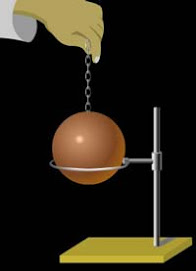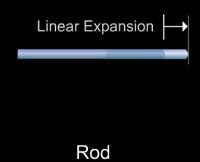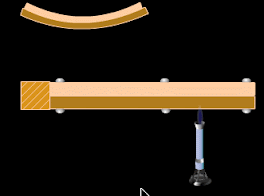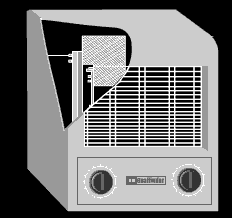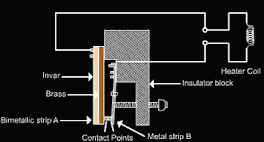EXPANSION
Most substances expand when heated and contract when cooled.The change in length / area or volume (due to contracting/expanding) is directly related to temperature change. Every linear dimension increases by the same percentage with a change in temperature
Not all materials contract/expand at the same rate; the amount of contraction/expansion varies depending on the material. The coefficient of linear expansion, is a proportionality constant that determines the rate of change in length in different materials when they are heated and cooled.
Applications :
In thermometers, thermal expansion is used for measurement. Liquid expand more than solids. Stained red ethanol has a relatively large coefficient of cubic expansion than glass . Temperature can be measured as it rises through the capillary faster.
If a lid of a glass jar is tight, holding it under hot water for a short time will make it easier to open. This is because the lid will be struck by the hot water more directly than the glass, and so it will expand sooner. Furthermore, metals generally expand more than glass for the same temperature change.
Problems:
- If steel bridge expand or contract, it can cause structural damage.However, steel bridges are often mounted on rollers to prevent this problem.-Expansion gaps also exist in train tracks.
-Water and steam pipes often have a U-bend in them to allow for thermal expansion.
Not all materials contract/expand at the same rate; the amount of contraction/expansion varies depending on the material. The coefficient of linear expansion, is a proportionality constant that determines the rate of change in length in different materials when they are heated and cooled.
Applications :
In thermometers, thermal expansion is used for measurement. Liquid expand more than solids. Stained red ethanol has a relatively large coefficient of cubic expansion than glass . Temperature can be measured as it rises through the capillary faster.
If a lid of a glass jar is tight, holding it under hot water for a short time will make it easier to open. This is because the lid will be struck by the hot water more directly than the glass, and so it will expand sooner. Furthermore, metals generally expand more than glass for the same temperature change.
Problems:
- If steel bridge expand or contract, it can cause structural damage.However, steel bridges are often mounted on rollers to prevent this problem.-Expansion gaps also exist in train tracks.
-Water and steam pipes often have a U-bend in them to allow for thermal expansion.
BIMETAL KONSEP
A BI-metallic strip works on the principle that different metals have different coefficients of expansion. A BI-metallic strip consists of two strips of different materials but of equal length. These two strips are riveted together at different points along their lengths such that they cannot slip sideways. Typically a welding process is used for bonding, but rivets, bolts, adhesive and other fasteners can also be used.
On heating the strip, the metal having the higher coefficient of linear expansion expands more than the other metal and therefore the strip bends. The bending is such that the strip is concave on the side of the metal of low coefficient of expansion and convex on the side of the metal of large coefficient of expansion. On cooling the strip, the reverse happens. Now, the metal having a higher coefficient of expansion contracts more and is therefore on the concave side while the metal of low coefficient of expansion contracts less and is on the convex side.
Example : A BI-metallic strip is brass on one side and steel on the other. When heated over a Bunsen burner the strip curves toward the steel side. When cooled in liquid nitrogen, it curves the other way.
Applications of BI-metallic strip:Thermostat: A thermostat is a device used for maintaining a steady temperature. It's basically a thermometer attached to a switch, and it's job is to turn something on or off when the thermometer reaches a certain temperature. Its working is based on the behavior of a BI-metallic strip with the change in temperature.
Often long BI-metallic strips are coiled into spirals. By coiling a very long strip it becomes much more sensitive to small temperature changes. In a furnace thermostat, the same technique is used and a mercury switch is attached to the coil. The switch turns the furnace on and off.
Thermostats are used in many appliances such as electric press, heater, fire alarm, flash unit, refrigerator, and air conditioner etc.
On heating the strip, the metal having the higher coefficient of linear expansion expands more than the other metal and therefore the strip bends. The bending is such that the strip is concave on the side of the metal of low coefficient of expansion and convex on the side of the metal of large coefficient of expansion. On cooling the strip, the reverse happens. Now, the metal having a higher coefficient of expansion contracts more and is therefore on the concave side while the metal of low coefficient of expansion contracts less and is on the convex side.
Example : A BI-metallic strip is brass on one side and steel on the other. When heated over a Bunsen burner the strip curves toward the steel side. When cooled in liquid nitrogen, it curves the other way.
Applications of BI-metallic strip:Thermostat: A thermostat is a device used for maintaining a steady temperature. It's basically a thermometer attached to a switch, and it's job is to turn something on or off when the thermometer reaches a certain temperature. Its working is based on the behavior of a BI-metallic strip with the change in temperature.
Often long BI-metallic strips are coiled into spirals. By coiling a very long strip it becomes much more sensitive to small temperature changes. In a furnace thermostat, the same technique is used and a mercury switch is attached to the coil. The switch turns the furnace on and off.
Thermostats are used in many appliances such as electric press, heater, fire alarm, flash unit, refrigerator, and air conditioner etc.
Please to answer this question
- What are bimetallic strips ?
- Why BI-metallic strips bend?
- How is a bimetallic strip made ?
- What happens if both ends of a bimetallic strip are clasped together ?
- How it is used in a thermostat ?
- Do the strips bends due to being heated by the current ?
- How does the thermostat regulate the heat ?
- Where is the thermostat used ?
- How tightening or loosening the screw increases thermostat switching?
Essay..
Length of the copper bar at 30oC is 20 m, then it heated up to 80oC. Determine length of the copper bar now if linier expansion coefficient copper bar is 0.000017/oC
A Pyrex glass with initial length of 2 meters is heated up to 30 oC from initial temperature. Determine the length expansion of that glass if its length expansion coefficient is 0.00003/oC
A copper bar at 10 oC is 10 meter long, then it is heated up to 20 oC. Determine the length expansion of that copper bar during the heating process if its expansion coefficient is 0.000017/Co.
Sunday, February 27, 2011
Subscribe to:
Posts (Atom)
.jpg)

